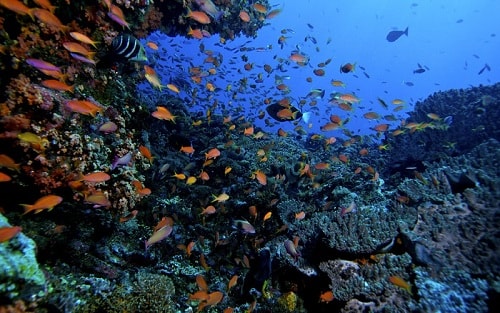About
Fish-T1K Project

With an estimated 32,000 species, ray-finned fishes represent over 50% of the global vertebrate biodiversity and encompass enormous variation in morphology, physiology, and ecology. Also, as the most abundant vertebrates and a primary source of protein for people worldwide, these fishes are an economically and ecologically significant group of animals.
Evolutionary mechanisms responsible for the extraordinary diversity of ray-finned fishes ("fishes") remain poorly understood. Despite their importance, fishes are relatively underrepresented in the total number of sequenced vertebrate genomes (www.genomesonline.org), with only about 13 fish genomes published so far. Transcriptome data are available for only 127 species of fishes (SRA of NCBI, as on March 2014), despite widespread use of RNA-seq next-generation Sequencing Technology. The majority of these species belong to just three orders, the Perciformes, Cypriniformes and Cyprinodontiformes. Lack of transcriptomic information underlying the vast diversity of fishes motivates the generation of new RNA-seq data to build a large-scale database of fish transcriptomes. This resource will enable better understanding of fish diversity, their special adaptations, phylogenetic relationships, and evolution.
Fish-T1K (Transcriptomes of 1,000 fishes) project was officially launched by BGI-Shenzhen in November 2013, with the aim of generating genome-wide transcriptome sequences (that is, the majority of expressed genes) for 1,000 diverse species of fishes using next-generation RNA sequencing technology (RNA-seq). This resource will greatly advance the study of fish biology, eventually contributing towards global fish biodiversity conservation efforts and sustainable utilization of natural resources. In addition, the project will promote development of new technologies and software for transcriptome sequencing, data analysis, annotation and storage.
Community
Steering Committee
Ying Sun, Marine Biobank, BGI Shenzhen, China
Qiong Shi, State Key Laboratory of Agricultural Genomics,BGI Shenzhen, China
Guillermo Ortí, Department of Biological Sciences, The George Washington University , USA
Byrappa Venkatesh, Institute of Molecular and Cell Biology, A*STAR, Singapore
Keith Crandall, Computational Biology Institute, The George Washington University, USA
Carole Baldwin, Smithsonian National Museum of Natural History, USA
Participating Institutions (in alphabetical order)
Since Fish-T1K’s inception in November 2013, 34 scientists from 20+ institutions worldwide in ichthyology, fish phylogeny, molecular biology, genomics and computational biology have joined the project.

- BGI (Shenzhen, China)
- China National Genebank (Shenzhen, China)
- China Fisheries Association (Beijing, China)
- CIIMAR, University of Porto (Porto, Portugal)
- Guangxi Mangrove Research Center (Beihai, China)
- Kunming Institute of Zoology of the Chinese Academy of Sciences (Yunnan, China)
- Institute of Oceanology, Chinese Academy of Sciences (Qingdao, China)
- Kunming Institute of Zoology of the Chinese Academy of Sciences (Yunnan, China)
- Natural History Museum of Denmark, University of Copenhagen (Copenhagen, Denmark)
- Nova Southeastern University (Florida, USA)
- Ocean Park Hong Kong(Hong Kong, China)
- Sanya Science & Technology Academy for Crop Winter Multiplication (Hainan, China)
- Smithsonian National Museum of Natural History (Washington, D.C, USA)
- South China Sea Institute of Oceanology of the Chinese Academy of Sciences (Guangzhou, China)
- South East Asian Aquarium (Singapore)
- Sun Yat-Sen University (Guangzhou, China)
- The George Washington University (Washington, D.C, USA)
- Third Institute of Oceanography, State Oceanic Administration (Xiamen, China)
- United States Department of Agriculture (Washington, D.C, USA)
- University of Victoria (Victoria, Canada)
- Yellow Sea Fisheries Research Institute of Chinese Academy of Fishery Sciences (Qingdao, China)
Partnerships
Fish-T1K has built extensive global partnerships with many Omic-initiatives aiming to facilitate global biodiversity conservation and promote global research collaboration.
- AgENCODE
- DeepFin
- Genome 10K Project (G10k)
- Global Genome Biodiversity Network (GGBN)
- Global Genome Initiative (GGI)
- Tennenbaum Marine Observatories Network (TMON)
Contact
Ying Sun, sunying@genomics.cn, Marine Biobank, BGI Shenzhen, China
Qiong Shi, shiqiong@genomics.cn, State Key Laboratory of Agricultural Genomics,BGI Shenzhen, China
Guillermo Ortí, gorti@gwu.edu, Department of Biological Sciences, The George Washington University , USA
Byrappa Venkatesh, mcbbv@imcb.a-star.edu.sg, Institute of Molecular and Cell Biology, A*STAR, Singapore
Keith Crandall, kcrandall@gwu.edu, Computational Biology Institute, The George Washington University, USA
Carole Baldwin, baldwinc@si.edu, Smithsonian National Museum of Natural History, USA